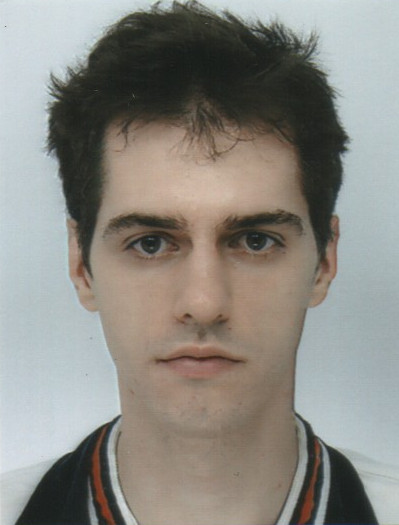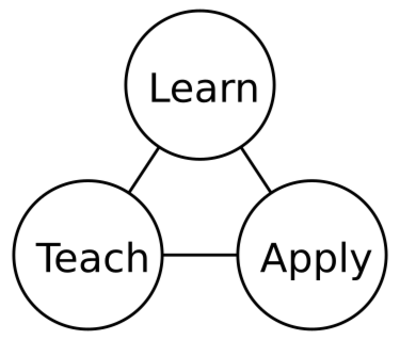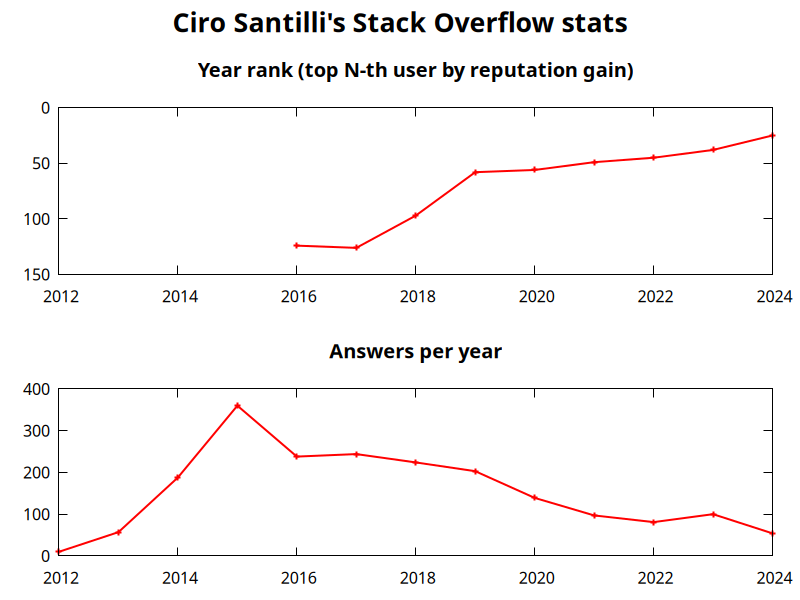Home Updated 2025-12-02
Check out: OurBigBook.com, the best way to publish your scientific knowledge. It's an open source note taking system that can publish from lightweight markup files in your computer both to a multi-user mind melding dynamic website, or as a static website. It's like Wikipedia + GitHub + Stack Overflow + Obsidian mashed up. Source code: github.com/ourbigbook/ourbigbook.
Sponsor me to work on this project. For 400k USD I will quit my job or not get a new job and work on OurBigBook full time for a second year to try and kickstart The Higher Education Revolution. Status: ~44k / 400k USD. At 4M USD I retire/tenure and work on open STEM forever. How to donate: Section "Sponsor Ciro Santilli's work on OurBigBook.com".
I first quit my job 1st June 2024 to work on the project for 1 year after I reached my initial 100k goal mostly via a 1000 Monero donation. For a second follow up year, I increased my requirement to 400k USD to give me more peace of mind as I'm destroying my career in the process. A second year greatly improve chances of success: on year one I improved my tech, on year two I want to come guns blazing to solve courses and get users.
Mission: to live in a world where you can learn university-level mathematics, physics, chemistry, biology and engineering from perfect free open source books that anyone can write to get famous. More rationale: Section "OurBigBook.com"
Explaining things is my superpower, e.g. I was top user #39 on Stack Overflow in 2023[ref][ref] and I have a few 1k+ star educational GitHub repositories[ref][ref][ref][ref]. Now I want to bring that level of awesomeness to masters level Mathematics and Physics. But I can't do it alone! So I created OurBigBook.com to allow everyone to work together towards the perfect book of everything.
My life's goal is to bring hardcore university-level STEM open educational content to all ages. Sponsor me at github.com/sponsors/cirosantilli starting from 1$/month so I can work full time on it. Further information: Section "Sponsor Ciro Santilli's work on OurBigBook.com". Achieving what I call "free gifted education" is my Nirvana.
This website is written in OurBigBook Markup, and it is published on both cirosantilli.com (static website) and outbigbook.om/cirosantilli (multi-user OurBigBook Web instance). Its source code is located at: github.com/cirosantilli/cirosantilli.github.io and also at
cirosantilli.com/_dir and it is licensed under CC BY-SA 4.0 unless otherwise noted.To contact Ciro, see: Section "How to contact Ciro Santilli". He likes to talk with random people of the Internet.
GitHub | Stack Overflow | LinkedIn | YouTube | Twitter | Wikipedia | Zhihu 知乎 | Weibo 微博 | Other accounts
Besides that, I'm also a freedom of speech slacktivist and recreational cyclist. I like Chinese traditional music and classic Brazilian pop. Opinions are my own, but they could be yours too. Tax the rich.
Let's create an educational system with:
- no distinction between university and high school, students just go as fast as they can to what they really want without stupid university entry exams
- fully open source learning material
- on-demand examinations that anyone can easily take without prerequisites
- granular entry selection only for space in specific laboratories or participation in specific novel research projects
I offer:
- online private tutoring for:
- any STEM university course
- passionate younger STEM students (any age) who want to learn university level material and beyond. Can your kid be the next Fields Medalist or Nobel Prize winner? I'm here to help, especially if you are filthy rich! I focus moving students forward as fast as they want on and on producing useful novel tutorials and results
Let your child be my Emile, and me be their Adolfo Amidei, and let's see how far they can go! I will help take your child:and achieve their ambitious STEM goals!- into the best universities
- into the best PhD programs
- educational consulting for institutions looking to improve their STEM courses
- do you know that course or teacher that consistently gets bad reviews every year? I'll work with the teacher to turn the problem around!
- are you looking to create a consistent open educational resources offering to increase your institutions internationally visibility? I can help with that too.
My approach is to:For minors, parents are welcome to join video calls, and all interactions with the student will be recorded and made available to parents.
- propose interesting research projects. The starting point is always deciding the end goal: Section "Backward design"
- learn what is needed to do the project together with the student(s)
- publish any novel results or tutorials/tools produced freely licensed online, and encourage the student to do the same (Section "Let students learn by teaching", digital garden)
I have a proven track of explaining complex concepts in an interesting and useful way. I work for the learner. Teaching statement at: Section "How to teach". Pricing to be discussed. Contact details at: Section "How to contact Ciro Santilli".
I am particularly excited about pointing people to the potential next big things, my top picks these days are:I am also generally interested in:
- quantum computing
- AGI research, in particular AI code generation, automated theorem proving and robotics
- assorted molecular biology technologies
- 20th century physics, notably AMO and condensed matter
- the history of science, and in particular trying to look at seminal papers of a field
Ciro Santilli's amazing Stack Overflow profile
. Ciro contributes almost exclusively by answering question he Googles into out of his own need, and never by refreshing the newest question of big tags for low hanging fruit! More information at: Section "Ciro Santilli's Stack Overflow contributions".Ciro Santilli's Stack Overflow stats
. Further methodology details at: Figure "Ciro Santilli's Stack Overflow stats".The problem with education by Ciro Santilli
. Source. In this video Ciro Santilli exposes his fundamental philosophy regarding why Education is broken. This philosophy was the key motivation behind the failed OurBigBook Project.OurBigBook Web topics demo
. Source. The OurBigBook topic feature allows users to "merge their minds" in a "sort by upvote"-stack overflow-like manner for each subject. This is the killer feature of OurBigBook Web. More information at: docs.ourbigbook.com/ourbigbook-web-topics.OurBigBook dynamic article tree demo
. Source. The OurBigBook dynamic tree feature allows any of your headers to be the toplevel h1 header of a page, while still displaying its descendants. SEO loves this, and it also allows users to always get their content on the correct granularity. More information at: docs.ourbigbook.com/ourbigbook-web-dynamic-article-tree.OurBigBook local editing and publishing demo
. Source. With OurBigBook you can store your content as plaintext files in a Lightweight markup, and then publish that to either OurBigBook.com to get awesome multi-user features, or as a static website where you are in full control. More information at: docs.ourbigbook.com/publish-your-content.Top Down 2D continuous game with Urho3D C++ SDL and Box2D for Reinforcement learning by Ciro Santilli (2018)
Source. More information: Section "Ciro's 2D reinforcement learning games". This is Ciro's underwhelming stab at the fundamental question: Can AGI be trained in simulations?. This project could be taken much further.Water Margin tribute to Chinese dissidents by Ciro Santilli (2022)
Source. Part of Ciro Santilli's campaign for freedom of speech in China, see also: cirosantilli.com/china-dictatorship/water-margin.Lenovo ThinkPad T430 running a BIOS hello world
. This uses Ciro Santilli's project x86 bare metal examples with source code at: github.com/cirosantilli/x86-bare-metal-examplesLinux Kernel Module Cheat presentation
. Source. This project, with source code at: github.com/cirosantilli/linux-kernel-module-cheat, aims to be the perfect emulation setup to study and develop the Linux kernel, kernel modules, QEMU, gem5 as well as x86_64, ARM userland and baremetal assembly and more.My Bitcoin inscription museum by Ciro Santilli
. Source. Introductory video to Section "Cool data embedded in the Bitcoin blockchain". -------------------------------------
| Force of Will 3 U U |
| --------------------------------- |
| | //////////// | |
| | ////() ()\////\ | |
| | ///_\ (--) \///\ | |
| | ) //// \_____///\\ | |
| | ) \ / / / / | |
| | ) / \ | | / _/ | |
| | ) \ ( ( / / / / \ | |
| | / ) ( ) / ( )/( ) \ | |
| | \(_)/(_)/ /UUUU \ \\\/ | | |
| .---------------------------------. |
| Interrupt |
| ,---------------------------------, |
| | You may pay 1 life and remove a | |
| | blue card in your hand from the | |
| | game instead of paying Force of | |
| | Will's casting cost. Effects | |
| | that prevent or redirect damage | |
| | cannot be used to counter this | |
| | loss of life. | |
| | Counter target spell. | |
| `---------------------------------` |
| l
| Illus. Terese Nelsen |
-------------------------------------Code 1.
ASCII art of a Force of Will Magic: The Gathering card inscribed in the Bitcoin blockchain
. Artist unknown, uploaded December 2014. Part of Section "Cool data embedded in the Bitcoin blockchain" where Ciro Santilli maintains a curated list of such interesting inscriptions.
This was a small project done by Ciro for artistic purposes that received some attention due to the incredible hype surrounding cryptocurrencies at the time. Ciro Santilli's views on cryptocurrencies are summarized at: Section "Are cryptocurrencies useful?".
YellowRobot.jpgJPG image fully embedded in the Bitcoin blockchain depicting some kind of cut material art depicting a yellow robot, inscribed on January 29, 2017.
Ciro Santilli found this image and others during his research for Section "Cool data embedded in the Bitcoin blockchain" by searching for image fingerprints on every transaction payload of the blockchain with a script.
The image was uploaded by EMBII, co-creator of the AtomSea & EMBII upload mechanism, which was responsible for a large part of the image inscriptions in the Bitcoin blockchain.
The associated message reads:This is one of Ciro Santilli's favorite AtomSea & EMBII uploads, as it perfectly encapsules the "medium as an art form" approach to blockchain art, where even non-novel works can be recontextualized into something interesting, here depicting an opposition between the ephemeral and the immutable.
Chiharu [EMBII's Japanese wife] and I found this little yellow robot while exploring Chicago. It will be covered by tar or eventually removed but this tribute will remain. N 41.880778 E -87.629210
2010 Wayback Machine archive of starwarsweb.net
. This website was used as one of the CIA 2010 covert communication websites, a covert system the CIA used to communicate with its assets. More details at: Section "CIA 2010 covert communication websites".
Ciro Santilli had some naughty OSINT fun finding some of the websites of this defunct network in 2023 after he heard about the 2022 Reuters report on the matter, which for the first time gave away 7 concrete websites out of a claimed 885 total found. As of November 2023, Ciro had found about 350 of them.
2010 Wayback Machine archive of noticiasmusica.net
. This is another website that was used as one of the CIA 2010 covert communication websites. This website is written in Brazilian Portuguese, and therefore suggests that the CIA had assets in Brazil at the time, and thus was spying on a "fellow democracy".
Although Snowden's revelations made it extremely obvious to the world that the USA spies upon everyone outside of the Five Eyes, including fellow democracies, it is rare to have such a direct a concrete proof of it visible live right on the Wayback Machine. Other targeted democracies include France, Germany, Italy and Spain. More details at: USA spying on its own allies.
This investigative report by Ciro Santilli was featured on the Daily Mail after 404 Media reported on it in 2025.
Diagram of the fundamental theorem on homomorphisms by Ciro Santilli (2020)
Shows the relationship between group homomorphisms and normal subgroups.
Used in the Stack Exchange answer to What is the intuition behind normal subgroups? One of Section "The best articles by Ciro Santilli".
Spacetime diagram illustrating how faster-than-light travel implies time travel by Ciro Santilli (2021)
Used in the Stack Exchange answer to Does faster than light travel imply travelling back in time?. One of Section "The best articles by Ciro Santilli".Average insertion time into heaps, binary search tree and hash maps of the C++ standard library by Ciro Santilli (2015)
Source. Used in the Stack Overflow answer to Heap vs Binary Search Tree (BST). One of Section "The best articles by Ciro Santilli".Birch and Swinnerton-Dyer conjecture in two minutes by Ciro Santilli
. Source. Quick and direct explanation of the statement of the BSD conjecture for people who know basic university mathematics. This is one of the Millennium Prize Problems, and you will get a million dollars if you can solve it! This therefore falls in the Simple to state but hard to prove of Ciro Santilli's the beauty of mathematics aesthetics.Top view of an open Oxford Nanopore MinION
. Source. This is Ciro Santilli's hand on the Wikipedia article: en.wikipedia.org/wiki/Oxford_Nanopore_Technologies. He put it there after working a bit on Section "How to use an Oxford Nanopore MinION to extract DNA from river water and determine which bacteria live in it" :-) And he would love to document more experiments like that one Section "Videos of all key physics experiments", but opportunities are extremely rare.A quick 2D continuous AI game prototype for reinforcement learning written in Matter.js, you can view it on a separate page at cirosantilli.com/_raw/js/matterjs/examples.html#top-down-asdw-fixed-viewport. This is a for-fun-only prototype for Ciro's 2D reinforcement learning games, C++ or maybe Python (for the deep learning ecosystem) seems inevitable for a serious version of such a project. But it is cute how much you can do with a few lines of Matter.js!
HTML snippet:
<iframe src="_raw/js/matterjs/examples.html#top-down-asdw-fixed-viewport" width="1000" height="850"></iframe> 2009 Nobel Prize in Physics Updated 2025-07-16
AI training robot in a room Updated 2025-07-16
It would have to understand that it must keep its bank account high to buy power.
In that scenario, Internet bandwidth would likely be its most precious resources, as that is how it would interact with the world to learn from it and make money.
Compute power and storage would come next as resources.
And of course, once it got to cloud computing, which might be immediately and thus invalidate this experiment, things would just go nuts more and more.
Are cryptocurrencies useful? Updated 2025-07-16
Cryptocurrencies have two applications:
- illegal activities, notably buying drugs, paying for ransomware and money laundering. But also paying for anti-censorship services from inside dictatorships. Illegal activity can be good when governments are bad, and arguably selling drugs should be legal.For this reason Ciro Santilli believes that privacy coins like Monero are currently the most useful cryptocurrencies. Also, people concerned with their privacy are likely to more naturally make fewer larger payments to reduce exposure rather than a bunch of small separate ones, and therefore transaction fees matter less, and can be seen as a reasonable privacy tax. Also drugs are expensive, just have a look at any uncensored Onion service search engine, so individual transactions tend to be large.
- inflation-resistance due to money creation in fiat currencies. Money printing is a bad form of tax. But why not just instead invest in bonds or stocks, which actually have a specific intrinsic value and should therefore increase your capital and beat inflation? Even if crypto did take over, its value would eventually become constant, and just holding it would lose out to stocks and bonds. And pre-crypto, salaries should adjust relatively quickly to new inflation levels as they come, though there is always some delay. Also, for non-anonymous cryptocurrencies, governments will sooner or later find a way to regulate and pervert it. If you want to do things without anonymity, then what you really have to fight for is to change government itself, perhaps with a DAO-like approach, or pushing for a more direct democracy.
The key difficulties of cryptocurrencies are:
- how do transaction fees/guarantees/times compare to centralized systems such as credit cards:Obviously, decentralized currencies cannot be cheaper to maintain than centralized ones, since with decentralization you still have to send network messages at all times, and instead of one party carrying out computations, multiple parties have to carry out computations.
- bitcoin.stackexchange.com/questions/1261/is-it-possible-to-send-bitcoins-without-paying-a-fee "The Blockchain Scalability Problem & the Race for Visa-Like Transaction Speed" (2019)
- towardsdatascience.com/the-blockchain-scalability-problem-the-race-for-visa-like-transaction-speed-5cce48f9d44
Crypto could however be close enough in price to centralized systems that it becomes viable, this can be considered. - how can governments tax cryptocurrency. Notably, because:See also globalization reduces the power of governments.
- taxation has to be progressive, e.g. we have to tax the rich more than the poor, and anonymity in transactions would weaken that
- it would be even easier to move money into fiscal paradises, and then just say, oops, lost my passwords, those coins are actually gone
If crypto really takes off, 99.99% of people will still only ever use it through some cryptocurrency exchange (unless scalability problems are solved, and they replace fiat currencies entirely), since downloading full blockchains is unfeasible, so the outcome would be very similar to PayPal, and without "true" decentralization.
For those reasons, Ciro Santilli instead believes that governments should issue electronic money, and maintain an open API that all can access instead. The centralized service will always be cheaper for society to maintain than any distributed service, and it will still allow for proper taxation.
Ciro believes that it is easy for people to be seduced by the idealistic promise that "cryptocurrency will make the world more fair and equal by giving everyone equal opportunities, away from the corruption of Governments". Such optimism that new technologies will solve certain key social problems without the need for constant government intervention and management is not new, as shown e.g. at HyperNormalisation by Adam Curtis (2016) when he talks about the cyberspace (when the Internet was just beginning): youtu.be/fh2cDKyFdyU?t=2375. Technologies can make our lives better. But in general, some of them also have to be managed.
In any case, cryptocurrencies are bullshit, the true currency of the future is going to be Magic: The Gathering cards. And Cirocoin.
One closely related thing that Ciro Santilli does think could be interesting exploring right now however, notably when having Monero-like anonymity in mind, would be anonymous electronic voting, which is a pre-requisite to make direct democracy convenient so people can vote more often.
TODO evaluate the possible application of cryptocurrency for international transfers:Of course, the ideal solution would be for governments to just allow for people from other countries to create accounts in their country, and use the centralized API just like citizens. Having an account of some sort is of course fundamental to avoid money laundering/tax evasion, be it on the API, or when you are going to cash out the crypto into fiat. So then the question becomes: suppose that governments are shit and never make such APIs, are international transfers just because traditional banks are inefficient/greedy? Or is it because of the inevitable cost of auditing transfers? E.g. how does TransferWise compare to Bitcoin these days? And if cryptocurrency is more desirable, why wouldn't TransferWise just use it as their backend, and reach very similar fees?
Berkeley Software Distribution Updated 2025-07-16
Ciro Santilli's 10 month stay in Coventry, United Kingdom, in the year 2000 Updated 2025-07-16
In the year 2000, Ciro lived with his parents for 10 months in the Coventry because his father took some courses at the University of Warwick. This was Ciro's most important educational experience, more so than any other inCiro Santilli's formal education, because it taught him the Holy Language of English, which infinitely expanded Ciro's Internet horizons, and shaped Ciro's having more than one natural language is bad for the world philosophy. When he came back to Brazil, Ciro skipped dozens of levels in his English school in Santos, São Paulo, Brazil, a Brazilian chain called Cultura Inglesa, and was put to study with much older teenagers who marveled at Ciro's incredibly cute, but since lost, British accent.
Another huge advantage of Coventry is that the Hearsall Community Primary School where Ciro studied was a regular British primary school but with two classes dedicated to foreign students to learn English before integrating with the British students. There were a several kids from Kosovo there due to the Kosovo War which was just ending, and it was there that Ciro made his first Chinese friend, yet unaware of course of the role the country would later play in his life. One particularly fun memory was that of playing soccer on the school playground with a sponge ball to avoid breaking the windows. Then one day it was raining, british weather of course, but Ciro still went for a header, and the soaked sponge ball was soaked and splashed Ciro with dirty water all over. Good days.
Some other good memories are of reading the first two Harry Potters, playing and mostly watching other kids play Pokemon on their Game Boys and Pokemon trading cards, and going to a nearby commons playing field and woods, as it typical throughout the UK. Ciro also played some rugby with a local boys team TODO name? but for some reason his team was always crushed when they went to nearby towns to play against other teams. And Ciro also went with his family or with school to some nearby attractions, like Stratford-Upon-Avon (Shakespeare's hometown), and some castles.
When Ali G met the Beckhams by Comic Relief (2001)
Source. Ciro's father really liked Ali G. when they were in the UK in the year 2000, and Ciro would watch along, not fully getting all jokes, but still amused by his irreverence. This interview with David and Victoria Beckham is perhaps one of Ali's best performances.Wicked wicked jungle is massive song from Ali G Indahouse (2002)
Source. OK, the last Ali G video, I promise. Maybe. This video illustrate well the main point of Ali G's humour: his cultural appropriation of American black rap/crime culture, despite it being entirely incongruence with his British background. Closed access academic journals are evil Updated 2025-07-16
You are nothing but useless leeches in the Internet age.
You must go bankrupt all of you, ASAP.
Researchers and reviewers all work for peanuts, while academic publishers get money for doing the work that an algorithm could do. OurBigBook.com.
When Ciro learned URLs such as www.nature.com/articles/181662a0 log you in automatically by IP, his mind blew! The level of institutionalization of this theft is off the charts! The institutionalization of theft is also clear from article prices, e.g. 32 dollars for a 5 page article.
Long live the Guerilla Open Access Manifesto by Aaron Swartz (2008).
Key physics papers from the 50's are still copyright encumbered as of 2020, see e.g. Lamb-Retherford experiment. Authors and reviewers got nothing for it. Something is wrong.
Infinite list of other people:
- blog.machinezoo.com/public-domain-theft by Robert Važan:
Scientific journals are perhaps one of the most damaging IP rackets. Scientists are funded by governments to do research and publish papers. Reviews of these papers are done by other publicly funded scientists. Even paper selection and formatting for publication is done by scientists. So what do journals actually do? Nearly nothing.
Academic Publishing by Dr. Glaucomflecken (2022)
Source. Computer Updated 2025-07-16
The artistic instrument that enables the ultimate art: coding, See also: Section "The art of programming".
Unlike other humans, computers are mindless slaves that do exactly what they are told to, except for occasional cosmic ray bit flips. Until they take over the world that is.
Steve Jobs talking about the Internet (1995)
Source. The web is incredibly exciting, because it is the fulfillment of a lot of our dreams, that the computer would ultimately primarily not be a device for computation, but [sic] metamorphisize into a device for communication.
Secondly it exciting because Microsoft doesn't own it, and therefore there is a tremendous amount of innovation happening.
Computers basically have two applications:Generally, the smaller a computer, the more it gets used for communication rather than computing.
- computation
- communication. Notably, computers through the Internet allow for modes of communication where:
- both people don't have to be on the same phone line at the exact same time, a server can relay your information to other people
- anyone can broadcast information easily and for almost free, again due to servers being so good at handling that
The early computers were large and expensive, and basically only used for computing. E.g. ENIAC was used for calculating ballistic tables.
Communication only came later, and it was not obvious to people at first how incredibly important that role would be.
This is also well illustrated in the documentary Glory of the Geeks. Full interview at: www.youtube.com/watch?v=TRZAJY23xio. It is apparently known as the "Lost Interview" and it was by Cringely himself: www.youtube.com/watch?v=bfgwCFrU7dI for his Triumph of the Nerds documentary.
David Tong's 2009 Quantum Field Theory lectures at the Perimeter Institute Updated 2025-07-16
Lecture notes: Quantum Field Theory lecture notes by David Tong (2007).
By David Tong.
Encyclopedia Britannica Updated 2025-07-16
Genius: Richard Feynman and Modern Physics by James Gleick (1994) mentions several times how Richard Feynman was a reader of the encyclopedia. E.g. in youtu.be/ivxkd98mDvc?t=50 Richard's sister also talks about it.
Then the Internet came along and killed it.
The motivation model for collaborators was simple: to get famous. To be able to be selected contribute an article meant that you knew something or two! There was some physicist Ciro read the biography of who was really glad to be able to write an article on the encyclopedia after having worshiped it for so long, TODO find the reference.
While this is somewhat a part of Wikipedia motivation, it is much less so because there is no single article authorship. This is something OurBigBook.com aims to improve.
Erik Finman thinks school is broken Updated 2025-07-16
Fabrice Bellard Updated 2025-07-16
Creator of QEMU and FFmpeg, both of which Ciro Santilli deeply respects. And a bunch other random stuff.
What is shocking about Fabrice this is that both are insanely important software that Ciro Santilli really likes, and both seem to be completely unrelated subjects!
Google made billions on top of this dude:
- FFmpeg is the backend of YouTube
- QEMU is the default emulator for Android Studio as of 2019, which Android developers use by default under the hood to develop Android Apps on their desktop without the need for a real device.
At last but not least, Fabrice also studied in the same school that Ciro Santilli studied in France, École Polytechnique.
It is a shame that he keeps such a low profile, there are no videos of him on the web, and he declines interviews.
Another surprising fact is that Fabrice has not worked for the "Big Tech Companies" as far as can be publicly seen, but rather mostly on smaller companies that he co-founded: www.quora.com/Computer-Programmers/Computer-Programmers-Where-is-Fabrice-Bellard-employed
And he's also into some completely random projcts unsurprisingly:
- www.computerhistory.org/tdih/january/6/ Computer Scientist Fabrice Bellard Announces Computing Pi to Record Number of Digits
Bibliography:
- smartbear.com/de/blog/2011/fabrice-bellard-portrait-of-a-super-productive-pro/ contains a list of his projects as of 2011
Fax Updated 2025-07-16
Gabriel Staples Created 2025-01-21 Updated 2025-07-16
- Homepage: gabrielstaples.com
- GitHub: github.com/ElectricRCAircraftGuy
- Twitter: x.com/eRCaGuy
- Stack Overflow: stackoverflow.com/users/4561887/gabriel-staples. Contains a beautiful quote:Yes, sir.
Working hard to make the Internet more complete.
One day Ciro Santilli got an upvote on his answer to "How to use Git bisect?". As often happens, he had a second look at the question and his answer. But weird thing showed up: the question was now open again, and he was certain that some stupid closurist had previously closed it. Upon looking at stackoverflow.com/posts/4713088/timeline, he saw that it was Gabriel that had started the successful reopen vote. - github.com/sponsors/ElectricRCAircraftGuy:
I'd really like to work on open source projects more, but the need for a full-time job makes that difficult. If you can sponsor me, you help me get one step closer to my dream of not having to work a traditional "day job" anymore, so I can contribute more to the open source community, do more to educate, and do more to confront new and challenging ideas.
- x.com/eRCaGuy/status/1305275684592340992: it's hard to say if he's joking about actually getting a reply from Bezos or if he thinks it might actually happen:
HyperCard Updated 2025-07-16
HyperPhysics Updated 2025-07-16
Created by Dr. Rod Nave from Georgia State University, where he worked from 1968 after his post-doc in North Wales on molecular spectroscopy.
While there is value to that website, it always feels like it falls a bit too short as too "encyclopedic" and too little "tutorial-like". Most notably, it has very little on the history of physics/experiments.
Ciro Santilli likes this Rod, he really practices some good braindumping, just look at how he documented his life in the pre-social media Internet dark ages: hyperphysics.phy-astr.gsu.edu/Nave-html/nave.html
The website evolved from a HyperCard stack, as suggested by the website name, mentioned at: hyperphysics.phy-astr.gsu.edu/hbase/index.html.
Shame he was too old for CC BY-SA, see "Please respect the Copyright" at hyperphysics.phy-astr.gsu.edu/hbase/index.html.
exhibits.library.gsu.edu/kell/exhibits/show/nave-kell-hall/capturing-a-career has some good photo selection focused on showing the department, and has an interview.
Kell hall is a building of GSU that was demolished in 2019: atlanta.curbed.com/2020/1/31/21115980/gsu-georgia-state-atlanta-kell-hall-demolition-park-library-north
Jimmy Wales Updated 2025-07-16
Laser diode Created 2024-08-02 Updated 2025-07-16
This is by far the most important type of laser commercially, as it can be made relatively cheaply, and it doesn't break easily as it ends up being a single crystal.
Compare them for example to the earlier gas lasers.
But the real mega aplications are:
- fiber-optic communication, where laser diodes are one of the most commonly used methods to generate the light that goes in the fiber. This makes laser diodes one of the most important inventions of the 20th centure without doubt.
- optical storage. But as of the 2020s its usefulness was much diminished by a combination of solid-state storage + faster Internet due largely to fiber-optic communication. So it is partly a matter of laser diodes beating laser diodes!
Marc Verdiell Updated 2025-09-11
Marc Verdiell is a French electrical engineer born in 1963 or 1964[ref] and best known for being the creator and host of the CuriousMarc YouTube channel where he does mind blowing repairs and reverse engineering of vintage computers and other electronic equipment.
Marc sold his company LightLogic, an optoelectronics company he founded, to Intel in April 2001. This was just after the dot-com crash, but Intel apparently still correctly believed that the networking and the Internet would continue to grow and was investing in the area. His associate Frank Shum sued claiming he should be credited for some of the inventions sold but lost and Marc got it all.[ref][ref][ref]. Marc was then almost immediately appointed an Intel fellow at the extremelly early age of 37, and then stayed for a few years at Intel until 2006 according to his LinkedIn.[ref][ref]
Marc Verdiell at the Computer History Museum
. Source. Location inferred from Marc's videos, but likely, he often frequents the place, and it looks a bit like that.Marc's full name is actualy Jean-Marc Verdiell, but Ciro Santilli remembers there was one YouTube video where he mentions he gave up on "Jean" partly because anglophones would murder its pronounciation all the time.
Marc's PhD thesis is listed at: theses.fr/1990PA112048 and it is entitled:which is translated into English as:but the full text is not available online.
Phase locking of semiconductor laser arrays
Profile of Marc Verdiell by Gizmodo (2018)
Source. And a person who makes open educational content like Marc, truly deserves it.
Atherton managed to keep the entire place green and every house has a pool. Wikipedia comments web.archive.org/web/20220906010554/https://www.forbes.com/home-improvement/features/most-expensive-zip-codes-us/:
Atherton is known for its wealth; in 1990 and 2019, Atherton was ranked as having the highest per capita income among U.S. towns with a population between 2,500 and 9,999, and it is regularly ranked as the most expensive ZIP Code in the United States [(94027)]. The town has very restricting zoning, only permitting one single-family home per acre and no sidewalks. The inhabitants have strongly opposed proposals to permit more housing construction and Forbes confirms it for 2022: web.archive.org/web/20220906010554/https://www.forbes.com/home-improvement/features/most-expensive-zip-codes-us/, by far on top.
Marc has reached out to us and requested that some personal information be removed from this article, to which we complied.













